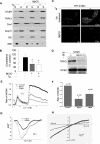Lipid rafts determine clustering of STIM1 in endoplasmic reticulum-plasma membrane junctions and regulation of store-operated Ca2+ entry (SOCE)
- PMID: 18430726
- PMCID: PMC2427359
- DOI: 10.1074/jbc.M800107200
Lipid rafts determine clustering of STIM1 in endoplasmic reticulum-plasma membrane junctions and regulation of store-operated Ca2+ entry (SOCE)
Abstract
Store depletion induces STIM1 to aggregate and relocate into clusters at ER-plasma membrane junctions where it functionally interacts with and activates plasma membrane channels that mediate store-operated Ca(2+) entry (SOCE). Thus, the site of peripheral STIM1 clusters is critical for the regulation of SOCE. However, what determines the location of the STIM1 clusters in the ER-PM junctional regions, and whether these represent specific sites in the cell is not yet known. Here we report that clustering of STIM1 in the subplasma membrane region of the cell and activation of TRPC1-dependent SOCE are determined by lipid raft domains (LRD). We show that store depletion increased partitioning of TRPC1 and STIM1 into plasma membrane LRD. TRPC1 and STIM1 associated with each other within the LRD, and this association was dynamically regulated by the status of the ER Ca(2+) store. Peripheral STIM1 clustering was independent of TRPC1. However, sequestration of membrane cholesterol attenuated thapsigargin-induced clustering of STIM1 as well as SOCE in HSG and HEK293 cells. Recruitment and association of STIM1 and TRPC1 in LRD was also decreased. Additionally STIM1(D76A), which is peripherally localized and constitutively activates SOCE in unstimulated cells, displayed a relatively higher partitioning into LRD and interaction with TRPC1, as compared with STIM1. Disruption of membrane rafts decreased peripheral STIM1(D76A) puncta, its association with TRPC1 and the constitutive SOCE. Together, these data demonstrate that intact LRD determine targeting of STIM1 clusters to ER-plasma membrane junctions following store depletion. This facilitates the functional interaction of STIM1 with TRPC1 and activation of SOCE.
Figures




References
-
- Berridge, M. J., Bootman, M. D., and Roderick, H. L. (2003) Nat. Rev. Mol. Cell Biol. 4 517-529 - PubMed
-
- Parekh, A. B., and Putney, J. W. (2005) Physiol. Rev. 85 757-810 - PubMed
-
- Putney, J. W., Jr. (1990) Cell Calcium 11 611-624 - PubMed
-
- Venkatachalam, K., van Rossum, D. B., Patterson, R. L., Ma, H. T., and Gill, D. L. (2002) Nat. Cell Biol. 4 263-272 - PubMed
Publication types
MeSH terms
Substances
Grants and funding
LinkOut - more resources
Full Text Sources
Miscellaneous

